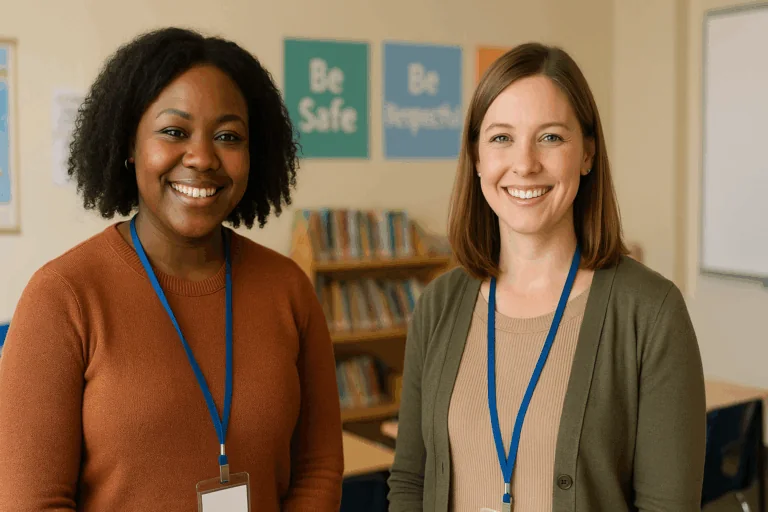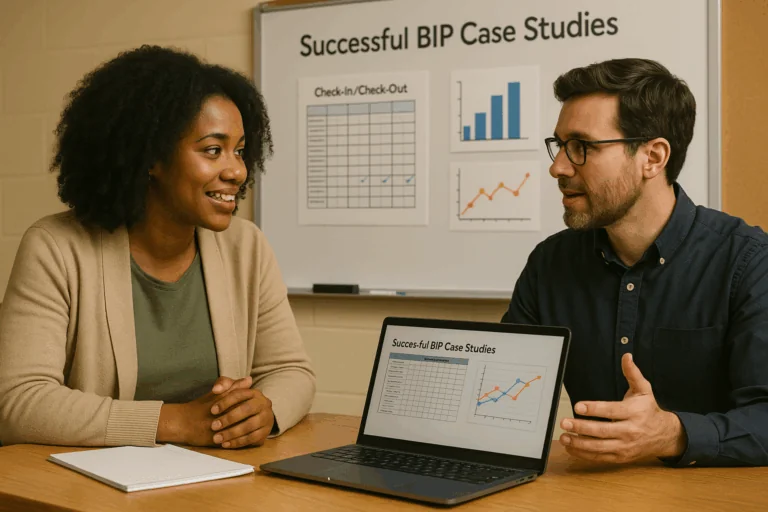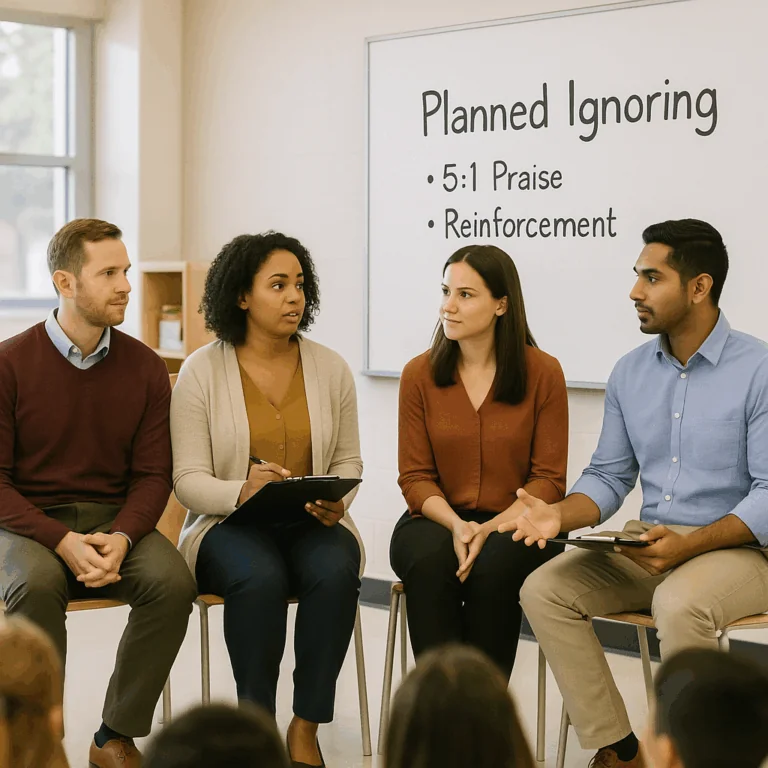School districts are facing a difficult moment. Budgets are shrinking, staffing shortages are real, and challenging student behaviors are on the rise across every grade level. Teachers are carrying more responsibility than ever – often without the support needed to manage behavior in a way that’s sustainable.
Yet, within every school system, there are untapped leaders for behavior support – deans, site administrators, resource specialists, instructional coaches, behavior specialists, psychologists, and counselors – who already know the students, understand the environment, and care deeply about the school community.
Rather than searching (often unsuccessfully) for external experts, districts can build capacity from within by developing a Grow Your Own Behavior Coach model – one that is collaborative, values-based, and focused on consistency, not perfection.
This coaching approach can be supported and guided through Behavior Advantage, which provides structured behavior planning tools, strategy videos, and implementation resources – without adding complexity or overwhelming staff.
You can read more about the meaning of the terms Behavior Coach and Behavior Specialist.
Why “Grow Your Own”?
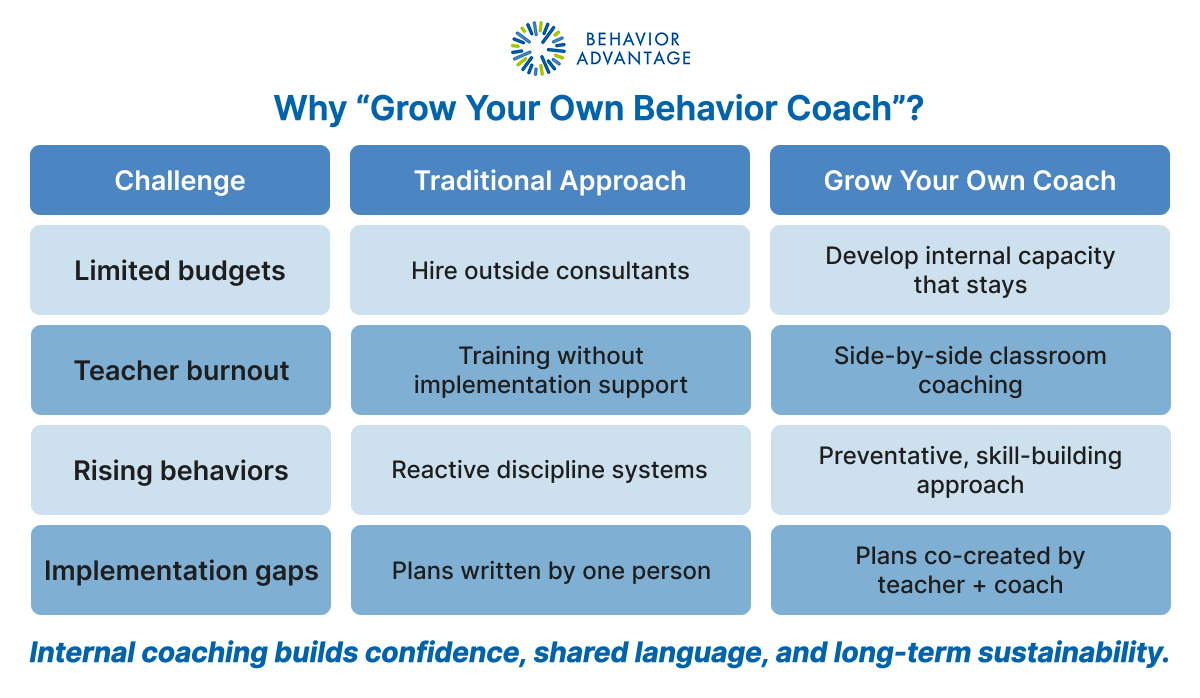
Internal coaching builds confidence, shared language, and long-term sustainability.
Guiding Mindset for the Behavior Coach
This approach is not about being an expert, fixing teachers or students, or evaluating classroom management.
It is about:
- You are a partner, not a fixer.
- Focus on small wins, not full solutions.
- Strive for progress, not perfection.
- Prioritize connection before correction.
- Build capacity, not dependency.
- Support conditions for growth, not quick fixes.
When teachers feel safe, respected, and supported, they are far more open to trying new strategies and sticking with them long enough to see change.
To make this vision actionable, consider the following step-by-step coaching flow—a practical roadmap for guiding teachers through growth and behavior change.
The Coaching Flow
Phase 1: Connect & Build Trust
Goal: Create a relationship where the teacher feels supported, not judged, and safe to ask for help.
Before meaningful change can occur, trust has to come first. In the early phase of coaching or collaboration, the focus isn’t on fixing problems; it’s on understanding the classroom, the teacher’s perspective, and the pressures they’re facing.
When teachers feel genuinely seen and valued, they’re far more open to reflection, feedback, and trying new strategies.
Warm introduction:
“I’m here to learn your classroom and support the goals that matter to you.”
Brief non-evaluative observation (5–10 minutes)
Ask reflective questions:
“What feels hardest right now?”
“When does the class run more smoothly?”
Why say this:
These questions shift the conversation from judgment to problem-solving. They demonstrate curiosity about the teacher’s lived experience and help identify when things go well—key data for scaling success.
Validate:
“Anyone in your position would feel the same.”
Partnership commitment:
“We’ll take this step by step—together.”
Why say this:
Validation reduces defensiveness, and partnership language builds psychological safety. It establishes that this is a shared effort, not an evaluation.
Takeaway:
Trust → Openness → Collaboration → Change.
Phase 2: Clarify Values & Identify a Focus
Goal: Help the teacher define what success looks like in their classroom by aligning desired outcomes with daily routines and observable behaviors.
Once trust is established, the next step is to focus the work. This phase moves from general frustration (“Everything feels hard right now”) to purposeful clarity (“Here’s one place we can start”).
Ask:
“What would you love to see happening more often?”
Why say this:
This reframes the conversation toward building positives instead of reducing problems. It connects goals to teacher values—like community, respect, or engagement—so strategies align with what matters most to them.
Choose one routine or time of day to start with.
Make it concrete:
Instead of: “Improve behavior.”
Say: “Students will raise their hands before speaking out.”
Why do this:
Narrowing the focus makes success achievable. One small, observable target helps teachers notice improvement quickly and builds confidence.
Takeaway:
If everything is a priority, nothing is.
Phase 3: Co-Create a Simple, Sustainable Plan
Goal: Develop a clear, realistic plan that aligns with the teacher’s goals, feels doable, and sets the stage for measurable progress.
After clarifying the focus, it’s time to create a plan that fits the teacher’s day. Simplicity matters—one or two strategies implemented consistently will always outperform a long list that never makes it into practice.
Use Behavior Advantage tools to:
- Capture the shared focus (Target Behavior or Skill to Teach)
- Select 1–2 core strategies and develop a manageable plan
- Set one small weekly goal
You can learn more about how we can help you and your team achieve your goals in this comprehensive guide.
Teacher reflections:
“It took the pressure off me. I wasn’t expected to fix everything—I was learning too.”
“Having a simple daily plan actually made me more mindful. It wasn’t overwhelming—just clear.”
Why say this:
Framing the process as learning with the teacher—not doing for them—creates empowerment. Plans grounded in collaboration and simplicity lower anxiety and build ownership.
Takeaway:
Small, co-created plans build momentum, not fatigue. Clarity fuels consistency.
Phase 4: Teach & Model the Strategies
Goal: Support implementation through modeling, practice, and feedback so strategies become part of the teacher’s daily rhythm.
This is where the plan comes to life. Implementation support bridges the gap between knowing what to do and feeling confident doing it.
Use:
- Short strategy videos in Behavior Advantage
- Co-teaching or modeling in authentic classroom settings
- Guided practice or brief role-play sessions
Looking for strategies to try out? Have a look at this list of strategies that we have carefully prepared.
Coach reflection:
“The plan helped me be a better mentor. We had shared language, and I knew exactly what to model.”
Teacher reflection:
“This helped build consistency—in me, in the students, and in the classroom culture.”
Why say this:
Modeling transforms abstract strategies into tangible examples. It also reinforces partnership: the coach isn’t prescribing—they’re demonstrating and practicing alongside the teacher.
Takeaway:
Confidence grows from trying, not mastering, on day one.
Phase 5: Follow-Up & Celebrate Wins
Goal: Strengthen habits and confidence through consistent reflection, feedback, and celebration of progress, no matter how small.
Lasting change depends on follow-through. Short, intentional check-ins (5–10 minutes) keep the plan alive and evolving.
Ask:
“What went better this week?”
“What felt hard?”
“What’s one small adjustment we can try next?”
Why say this:
These prompts foster reflection without judgment and help teachers self-assess what’s working. They turn “coaching” into a shared cycle of learning.
Celebrate small changes:
Even a 5% improvement is progress worth noticing.
Teacher reflection:
“We built community and relationships faster because we were reflecting and adjusting together.”
Takeaway:
Consistency compounds—slowly, then suddenly.
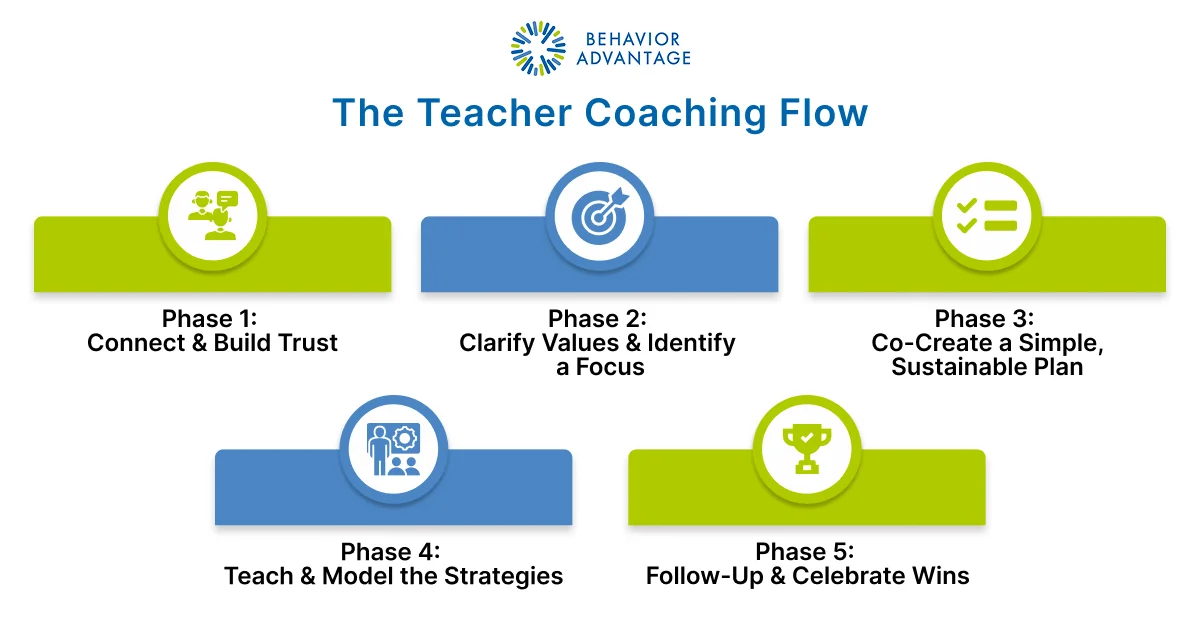
Communicate Like a Coach
The language we use shapes trust, reflection, and the willingness to try again. These simple phrases keep conversations grounded in empathy and partnership:
- Curiosity: “Tell me more about that moment.”
- Validation: “That reaction makes sense.”
- Partnership: “We’ll figure this out together.”
- Small Steps: “What’s one doable 10% improvement?”
Why This Works
Real change doesn’t come from a document—it comes from relationships and repetition.
Consistent, relational coaching centered on shared goals and small steps.
Teachers who have used this model report:
- Less pressure
- More confidence
- Stronger community
- Clear routines that support behavior proactively
- Faster relationship-building
And because this model develops internal leaders, the benefits stay in the school—year after year.
Ready to Grow Your Own Behavior Coaches?
When schools invest in people, not just programs, everyone wins.
By growing your own behavior coaches, you’re not just solving behavior challenges—you’re strengthening teacher confidence, consistency, and connection across your system.
Behavior Advantage makes it easy to start small and build momentum with tools and resources that guide each step of the coaching process.
Let’s explore what this could look like in your district.
Schedule a short walkthrough or strategy call – we’ll share sample coaching tools, real classroom examples, and help you identify your first internal coach.






